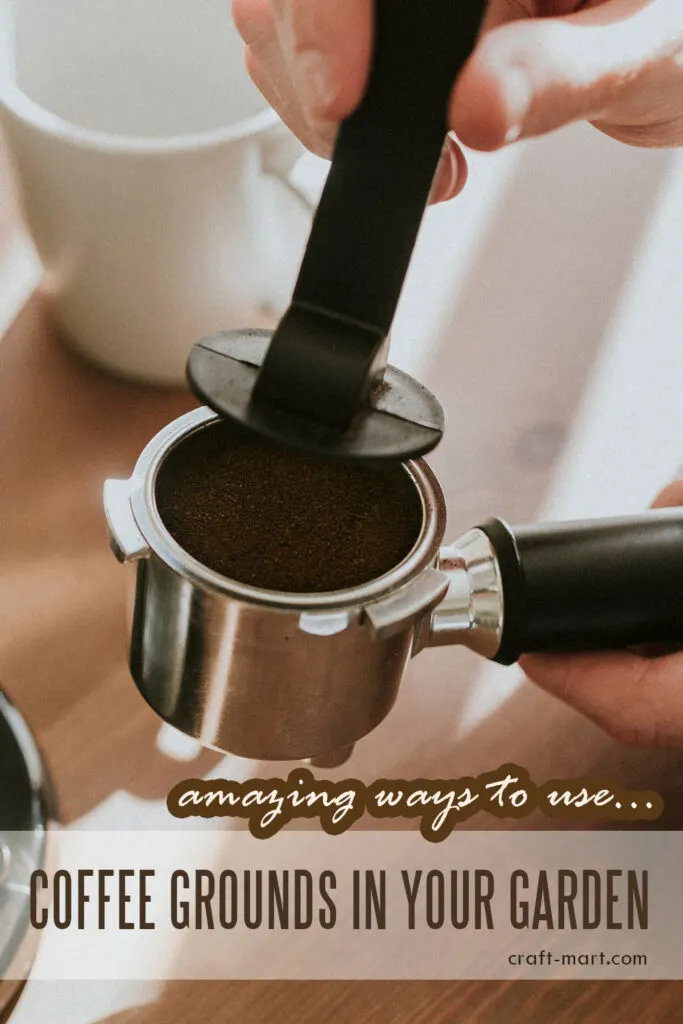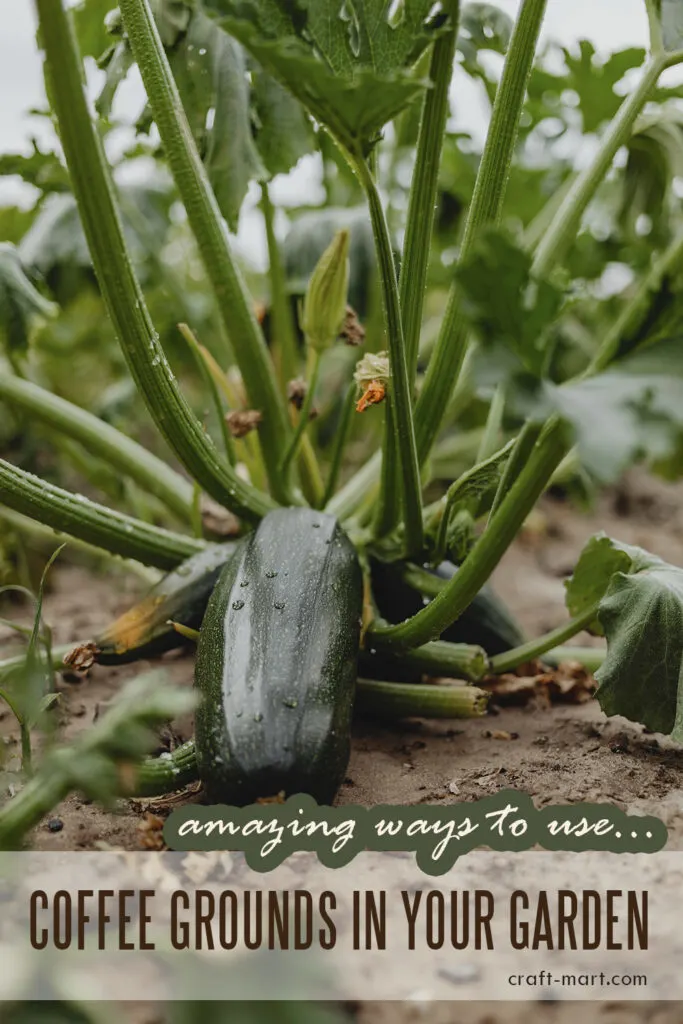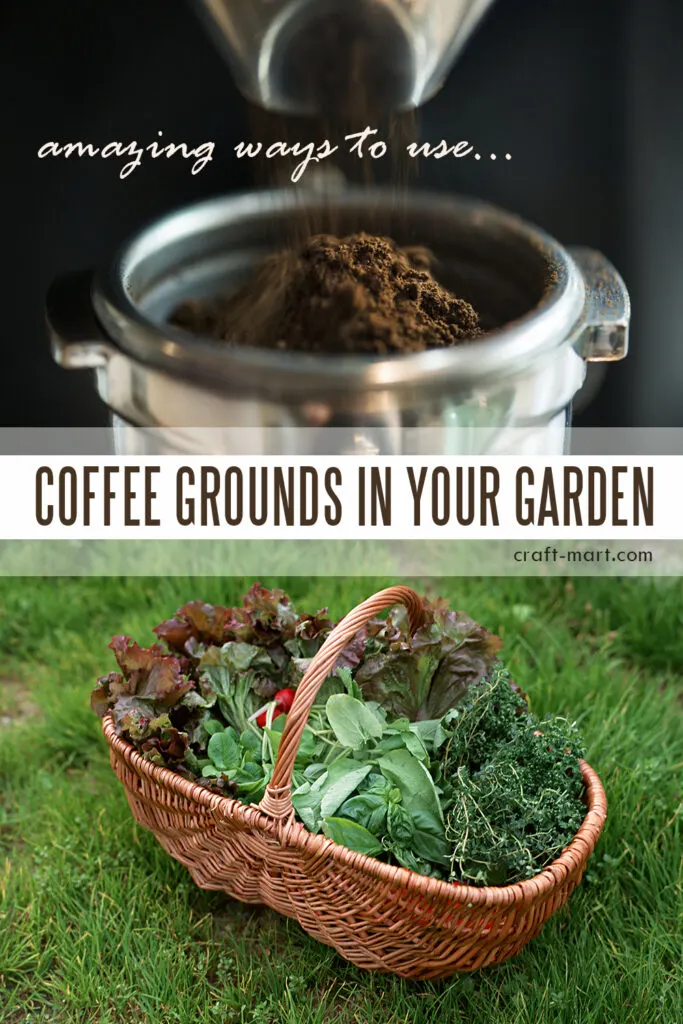If you are a coffee lover, learn how to use coffee grounds in your garden. In fact, those grounds could actually benefit your garden and you won’t see them go to waste.
In fact, we’ll show you ways to use coffee grounds in your garden, from fertilizing your plants to repelling pests. So not only will you be reducing waste, but you’ll also be giving your garden a boost.
Looking for more gardening ideas and hacks? Check out these posts:
- USDA Plant Hardiness Zones Map by Zip Code
- Easiest Vegetables to Grow from Scraps
- 9 Ways to Use Hydrogen Peroxide in Your Garden
Let’s dive in and explore the wonderful world of using coffee grounds in the garden.
Check out our FREE COFFEE PRINTABLES!

1. Add coffee grounds to the compost
One of the best ways to use coffee grounds in your garden is to add them to your compost pile. Coffee grounds contain nitrogen, which is an essential nutrient for plant growth.
When added to your compost, coffee grounds help to break down organic matter and create a nutrient-rich soil amendment. Be sure to turn your compost regularly to help it break down evenly and avoid any unpleasant odors.
To get started, simply add your used coffee grounds to your compost bin or pile. You can also mix them with other organic materials. With leaves and grass clippings, they will create a balanced compost mix.
Adding coffee grounds to your compost is a simple and effective way to boost the nutrient content of your soil. Additionally, you’ll improve the overall health of your garden.
So next time you brew a pot of coffee, don’t throw those grounds away – save them for your compost instead!
2. Use coffee grounds as a fertilizer
Coffee grounds are not just useful for creating compost mixes. As a matter of fact, they can also be used as a fertilizer directly in your garden. The grounds are high in nitrogen, which is an essential nutrient for plant growth. By providing nitrogen to the soil, the coffee grounds can help improve the overall health of your plants.
To use coffee grounds as a fertilizer, simply sprinkle them directly on top of the soil around your plants. Be sure to spread them evenly and avoid creating clumps, which can cause issues with moisture retention.
Alternatively, you can mix the grounds into the soil before planting to help give your plants a boost. And if you have leftover grounds, add them to your compost pile to enhance the nutrient content of your soil.
Using coffee grounds as a fertilizer is an excellent way to repurpose something that would end up in the trash. Plus, it’s an affordable and easy solution for ensuring your plants get the nutrients they need to thrive.
3. Create a coffee ground mulch
If you’re looking for an easy way to give your plants some extra love, look no further than your morning cup of coffee. You can also create a coffee ground mulch to take things up a notch.
Spreading coffee grounds is a great way to create mulch around their base. This will help protect the soil from moisture loss, suppress weed growth, and add nutrients back into the soil.
To make coffee ground mulch simply spread the used grounds around the base of your plants. In fact, be careful not to cover the stems or leaves.
By spreading the used coffee grounds around your plants, you’ll be giving them a nutrient-rich protective layer. Furthermore, this will help keep moisture in and weeds out.
But that’s not all coffee grounds can do for your garden. Up next, we’ll explore how these favorite beans can be used to repel snails and slugs.
Organically, you will be making your garden a happier and healthier place for your plants to grow.

4. Repel snails and slugs with coffee grounds
Coffee grounds have been a staple in the garden, as a natural fertilizer and an effective way to keep weeds away. But did you know that coffee grounds can also be used to repel snails and slugs?
These slimy creatures are notorious for munching on plant leaves. Consequently, hungry pests can cause extensive damage to your garden.
However, caffeine is toxic to these pests and can discourage them from making a meal out of your plants.
To use coffee grounds as a snail and slug repellent, simply sprinkle them around the base of your plants. Alternatively, you can create a barrier around your garden bed.
As the coffee grounds break down, they release a scent that snails and slugs find unappealing.
This means fewer of these pests snacking on your plants and more healthy foliage for your garden to enjoy.
5. Add coffee grounds to vermicompost
But don’t stop at just using coffee grounds as a snail and slug repellent. You can also add them to your vermicompost to enrich the soil and provide a food source for your worms.
By continually adding coffee grounds to your vermicompost, you’ll be able to create nutrient-rich soil. As a result, that will help your garden thrive. Coffee grounds have many benefits for your garden, and one of them is adding them to your vermicompost.
Vermicomposting is a process that involves the use of worms to break down organic materials into nutrient-rich soil. Worms are great at breaking down coffee grounds, and they love to feed on them.
By adding coffee grounds to your vermicompost, you’ll be giving your worms a food source. Consequently, this will help them thrive and break down other organic materials even faster.
In addition to being an excellent food source for your worms, coffee grounds also add nitrogen to your soil. Nitrogen is a vital nutrient for plant growth, and coffee grounds are an excellent source of it.
Adding coffee grounds regularly to your vermicompost will help create a nutrient-rich soil that your plants will love.
But remember to use coffee grounds in moderation, as too much can be harmful to your worms. A good rule of thumb is to add no more than 25% coffee grounds to your vermicompost.
Now that you know the benefits of adding coffee grounds to your vermicompost, it’s time to explore other surprising ways to use them.
6. Cultivate mushrooms using coffee grounds
Did you know that you can cultivate mushrooms in your garden using coffee grounds as a substrate? This is a clever way to grow your own organic mushrooms while recycling coffee waste.
With just a few steps, you can create a mushroom-growing medium that is rich in nutrients and easy to maintain. Simply mix coffee grounds with mushroom spores and wait for them to grow. Mushrooms are a great source of protein and add a unique flavor to any dish.
After harvesting your mushrooms, you can use the leftover coffee grounds as compost or soil amendment. They will continue to nourish your plants with their high nitrogen content.
By adding coffee grounds to your garden, you can create a sustainable cycle of growth and reuse. From vermicomposting to mushroom cultivation to skincare, coffee grounds have a multitude of uses beyond your morning cup of joe. So the next time you brew your coffee, don’t throw away the grounds – put them to work in your garden.
7. Make a coffee ground scrub
After working in your garden, your hands (and feet) may need some extra care. Coffee grounds are not only great for your garden, but they also make an excellent ingredient for a homemade scrub.
With just a few simple ingredients, you can create an eco-friendly exfoliator. As a result, your skin will feel soft and refreshed.
To make a coffee ground scrub, mix together your leftover coffee grounds with a natural oil such as coconut oil. You can also add a teaspoon of honey for added moisturizing benefits.
Read more about other surprising scrubs: Incredible homemade sugar scrubs benefits you should know about.
Gently massage the mixture onto your skin in a circular motion. Focus on areas that need extra attention such as your heels and hands. Then, rinse off with warm water to reveal smooth and glowing skin.
Not only is this scrub easy to make, but it’s also a great way to repurpose your coffee grounds. After all, why waste something that can be used in so many ways?
So not only will you be pampering yourself with a luxurious scrub, but you’ll also be supporting your garden’s ecosystem. It’s a win-win!
8. Create a foliage spray
Using coffee grounds in your garden has numerous benefits, and one of them is using them in creating a natural foliage spray. So, while you’re enjoying your cup of coffee every morning, don’t just throw away the grounds.
Instead, collect them and soak them in water. You can use the mixture as a garden spray for your plants.
Spray the whole plant, including both sides of the leaves. Gardeners believe that the smell of coffee will help to keep insects and pests away.
In addition, the coffee grounds add nutrients to the water which will strengthen the plants. As a result, it will give your garden a boost.
On the positive side, plants love coffee but the animals do not. Looking for ways to keep annoying pets from destroying your lawn? Learn how used coffee grounds can help.

10. Ward off animals with used coffee grounds
Animals can wreak havoc in your garden. Do you know that used coffee grounds can keep unwanted visitors away from your garden and lawn?
In fact, many animals, including dogs and cats, don’t like the smell of coffee. As a result, used coffee grounds can keep them from making themselves at home in your garden.
Simply spread coffee grounds where you don’t want neighbors’ pets to relieve themselves. Adding coffee grounds to raised beds and flower beds will solve the problem.
In summary, there are many ways to use coffee grounds in your garden beyond just throwing them away. Experiment with these methods and see which ones work best for your plants.
Not only will you be doing your part to reduce waste, but you’ll also be able to enjoy a thriving garden. So next time you brew a cup of coffee, save those grounds and put them to good use!
